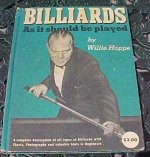Slh:
The advantages are that it lessens certain parts of your hand from "getting in the way" during the time that your hand cantilevers through the stroke.
In a typical two-finger grip (index + middle + thumb), you have to solve the problem of the rear/unused fingers (and the heel of the hand as well) from getting in the way / rubbing on the cue / imparting sideways pressure. Some folks will flay those fingers outward; others will fold the pinkie inwards and rest the side of the cue against that pinkie's fingernail as sort of a "spacer/governer." Still others will arch their hand slightly outwards.
A rear-fingered grip solves all of these problems by making the rear of the hand itself be the pivot/hinge point. There's nothing "back there" to bump or rub against the cue (and thus inducing a steer or yaw), because the cue is pivoting or hinging back there to begin with.
A good analogy would be throwing a dart. One holds the dart in front of his/her face, pinched between the thumb, and either just the index finger, or perhaps the index and middle fingers. The rear of the hand (ring and pinkie fingers) are in the front, ahead of the fingers actually holding the dart. They are essentially unused. But when you throw the dart, those unused fingers "fly outwards and away" much like a
sabot on a bullet. In the same way, a rear-fingered grip on a cue leaves the front fingers (index + middle fingers) unused, and when delivering the cue, these front fingers fly outwards and away, in sabot fashion.
I hope that description helps!
-Sean
